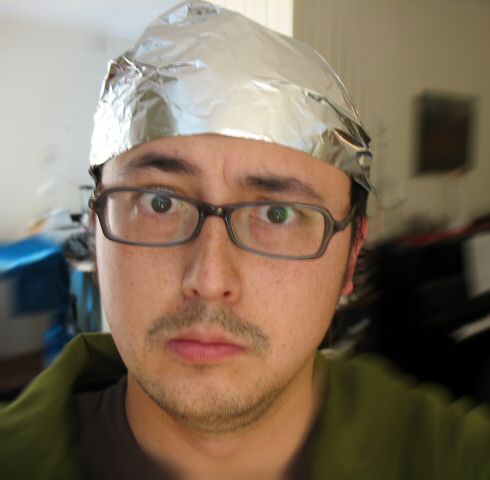What's with all the current tin foil hats?

Paranoia and conspiracy theory believe are often symbolized by the wearing of tin foil hats. Wearing a tin foil hat is known as by some to safeguard one's mind from government surveillance.
Aluminum foil, the material used to create these caps, is famous for its capability to deflect electromagnetic waves. Some individuals who believe in conspiracies believe that wearing a tin foil hat would make them immune to chemtrails, mind control, and extraterrestrial abduction.
Paranoia
Paranoia is a mental illness seen as a an irrational concern with others. A lot of things, including heredity, abuse, traumatic experiences, and suppressed feelings, might donate to its development. Medications like anti-anxiety and anti-psychotic medicines may potentially cause this problem. Paranoid people could have trouble confiding in doctors and hence defer getting help. They could not want to take their prescription at all. Paranoia may be treated using talk therapy, cognitive behavioral therapy, as well as in a group setting.
Many people who believe in paranormal phenomena, such as government mind control, chemtrails, alien abduction, and so on, wear tin foil hats for protection. They think that by wrapping their heads in tin foil, they could protect themselves against cancer, dementia, and Alzheimer's disease caused by radiofrequency (RF) and electromagnetic fields (EMF).
Those who have problems with paranoia often deny they have a concern and insist their anxieties are reasonable. Show your support and urge them to get expert help. But don't inform them they're crazy or out of touch; that'll only make them more anxious and suspicious. Instead, you should comfort them and suggest that together you see a doctor or call the SANE line.
Ideas of a hidden hand
Aluminum foil is sewn into hats in the assumption that doing so would shield the wearer's brain from the government's efforts at mind control through electromagnetic radiation. This theory is founded on the Faraday cage phenomenon, in which an enclosure built of conducting material effectively shields its contents from electromagnetic and radio waves. However, this hypothesis isn't grounded on solid scientific data and is instead mostly the consequence of pseudoscience.
Believing that tinfoil hats must have been planned by someone?a belief referred to as a "conspiracy theory"?is an exemplory case of an epistemic demand. make a tinfoil hat have a tendency to increase in the face of ambiguity and dissatisfaction with evidence-based explanations (Douglas et al., 2019). As previously discussed (Jolley & Douglas, 2017), those who hold conspiracy theories are also more inclined to oppose government efforts to boost vaccination rates or preserve personal privacy.

It's become common for members of the "truth movement" and the ones who fear the negative consequences of technology to wear tin foil hats in public areas. The assumption that exposure to radio waves and electromagnetic fields may cause cancer and other health concerns underlies this attitude. A few of these people have even tried using technological gadgets made to detect such invisible radiation. Tin foil may be used as a shield against electromagnetic radiation, however it is not nearly as effectual as other materials.
Hypersensitivity to electromagnetic fields (EHS)
Some individuals who wear them are truly affected by electromagnetic hypersensitivity (EHS), even though many who achieve this are paranoid and believe in conspiracy theories. Headaches, sore muscles, exhaustion, numbness or tingling in the extremities, hearing loss, nausea, a feeling of warmth or burning, and irregular heartbeat are signs of this condition. Despite widespread medical dismissal of EHS as a psychosomatic disorder, several patients have reported success with a wide range of treatments.

Copper wire shielding is frequently used by those that suffer from EHS to reduce their exposure to radiofrequency radiation (RFR) and alleviate their symptoms. In addition they claim to stay from radio frequency radiation (RFR) emitters including cell phones, Wi-Fi routers, TVs, and other electronics. Some people are so afraid of being around technological devices that they refuse to visit friends and relatives or even stay in hotels.
Despite tinfoil hat from the scientific community, it really is worth noting that EHS patients might experience unfavorable physical symptoms in a reaction to certain environmental signals, as revealed by a few studies. Because of this, it is crucial that researchers devise more accurate methods of diagnosing EHS symptoms and identifying environmental triggers. Additionally, anyone with EHS should seek professional medical attention.
An explanation of the Illuminati
The most widespread paranoid illusions in the contemporary era is that the Illuminati control the world. There are rumors that this underground organization controls governments and contains sway over famous people. There are certainly others who believe the Illuminati are responsible for everything from climate change to the NSA spying scandal. Conspiracy theories have already been around for a long time. It originally gained traction in the public consciousness during the counterculture era of the 1960s. Books, movies, and programs have all explored this phenomenon.
Adam Weishaupt, a disillusioned Bavarian Jesuit, established the first Illuminati in 1776, but the group's ultimate aim is definitely shrouded in mystery. Weishaupt claimed the church and the king were stifling free speech. The movement was finally put down and disbanded.
The theory that the Illuminati survives today is widely held. Proponents of the hypothesis often name high-profile public figures and politicians as types of those who participate in this cabal. They also attribute Illuminati meaning to the triangle with an eye on the reverse of American dollars. Some of the numerous places they think the occult is concealed is in contemporary architecture and monetary design.
Tin foil hat wearers say their headgear keeps them safe from EMFs along with other radiation. In addition they think the caps protect them from mind reading and mental control. The tin foil hat hypothesis is a stereotype for those who are too suspicious or believe in conspiracy theories, even though it does not have any scientific foundation.
